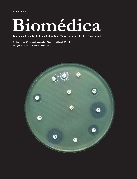Is drug-resistant Mycobacterium leprae a real cause for concern? First approach to molecular monitoring of multibacillary Colombian patients with and without previous leprosy treatment
Abstract
Introduction: There is no information in Colombia on Mycobacterium leprae primary and secondary drug resistance in regards to the WHO-multidrug therapy regime. On the other hand, public health authorities around the world have issued various recommendations, one of which prompts for the immediate organization of resistance surveillance through simple molecular methods.
Objective: To determine the prevalence of Mycobacterium leprae drug resistance to rifampicin, ofloxacin and dapsone in untreated and previously treated patients at the Centro Dermatológico Federico Lleras Acosta during the 1985-2004 period.
Materials and methods: We conducted a retrospective study which included multibacillary patient biopsies through elective sampling: 381 of them from new patients and 560 from previously treated patients. Using a microtome, we obtained six slides from each skin biopsy preserved in paraffin, and we extracted M. leprae DNA. We amplified three molecular targets through PCR and obtained the patterns of drug resistance to dapsone, rifampicin and ofloxacin by reverse hybridization. Finally, we collected epidemiological, clinical and demographical data for analyses.
Results: From 941 samples under study, 4.14% of them were resistant to one or more drugs, and 5.77 and 3.04% had resistant genotypes in new and previously treated patients, respectively. Total resistance for each drug was 0.43% for dapsone, 3.19% for rifampicin and 1.17% for ofloxacin. We found statistically significant differences for rifampicin and for the total population when comparing the results from untreated versus previously treated patients. Two thirds of the resistant samples were resistant to rifampicin alone or combined.
Conclusions: The standard multidrug therapy schemes continue being effective for leprosy cases; however, it is necessary to guarantee adherence and regularity. Surveillance to drug resistance in new and previously treated leprosy cases should be established.
Downloads
Some similar items:
- Angela Patricia Guerra, Angélica Knudson, Rubén Santiago Nicholls, John Alexander Galindo, Zaava Ravid, Sonia Rahirant, Nidia Duarte, Jacqueline Chaparro-Olaya, Moisés Wasserman, Genotyping of the Plasmodium falciparum msp1 (block 2) and dhfr (codon 108) genes in field samples collected in four endemic Colombian localities. , Biomedica: Vol. 26 No. 1 (2006)
- Constanza Pardo, Ricardo Cendales, Survival analysis of cervical cancer patients , Biomedica: Vol. 29 No. 3 (2009)
- Raúl Murillo, Ricardo Cendales, Carolina Wiesner, Marion Piñeros, Sandra Tovar, Effectiveness of cytology-based cervical cancer screening in the Colombian health system , Biomedica: Vol. 29 No. 3 (2009)
- Sandra Lorena Girón, Julio César Mateus, Fabián Méndez, Impact of an open waste disposal site on the occurrence of respiratory symptoms and on health care costs of children , Biomedica: Vol. 29 No. 3 (2009)
- José Joaquín Carvajal, Ligia Inés Moncada, Mauricio Humberto Rodríguez, Ligia del Pilar Pérez, Víctor Alberto Olano, Characterization of Aedes albopictus (Skuse, 1894) (Diptera:Culicidae) larval habitats near the Amazon River in Colombia , Biomedica: Vol. 29 No. 3 (2009)
- Andrés Páez, Gloria Rey, Carlos Agudelo, Alvaro Dulce, Edgar Parra, Hernando Díaz-Granados, Damaris Heredia, Luis Polo, Outbreak of urban rabies transmitted by dogs in Santa Marta, northern Colombia , Biomedica: Vol. 29 No. 3 (2009)
- Patricia Escobar, Katherine Paola Luna, Indira Paola Hernández, César Mauricio Rueda, María Magdalena Zorro, Simon L. Croft, In vitro susceptibility of Trypanosoma cruzi strains from Santander, Colombia, to hexadecylphosphocholine (miltefosine), nifurtimox and benznidazole , Biomedica: Vol. 29 No. 3 (2009)
- Gustavo Pradilla, Julio César Mantilla, Reynaldo Badillo, Human rabies encephalitis by a vampire bat bite in an urban area of Colombia , Biomedica: Vol. 29 No. 2 (2009)
- Mauricio Beltrán, María Cristina Navas, María Patricia Arbeláez, Jorge Donado, Sergio Jaramillo, Fernando De la Hoz, Cecilia Estrada, Lucía del Pilar Cortés, Amalia de Maldonado, Gloria Rey, Seroprevalence of hepatitis B virus and human immunodeficiency virus infection in a population of multiply-transfused patients in Colombia , Biomedica: Vol. 29 No. 2 (2009)
- Rosa Magdalena Uscátegui, Adriana M. Correa, Jaime Carmona-Fonseca, Changes in retinol, hemoglobin and ferritin concentrations in Colombian children with malaria , Biomedica: Vol. 29 No. 2 (2009)
| Article metrics | |
|---|---|
| Abstract views | |
| Galley vies | |
| PDF Views | |
| HTML views | |
| Other views | |


























